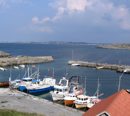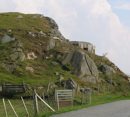 I was well on my way to spending a lazy Saturday reading on the couch but the wonderful weather outside convinced me I should hop on my uncle’s bicycle and go for an afternoon ride. I have blogged a little bit about some of these delightful afternoon rides that I took to Mosterøy and Rennesøy last summer. Today I rode along the western coast, passed the airport and Sola beach to the area known as Ølberg, now perhaps best known as the location of a small beach, harbor, cafe, and a few recreational cabins.
I was well on my way to spending a lazy Saturday reading on the couch but the wonderful weather outside convinced me I should hop on my uncle’s bicycle and go for an afternoon ride. I have blogged a little bit about some of these delightful afternoon rides that I took to Mosterøy and Rennesøy last summer. Today I rode along the western coast, passed the airport and Sola beach to the area known as Ølberg, now perhaps best known as the location of a small beach, harbor, cafe, and a few recreational cabins.

My hometown, Stavanger, is on a peninsula, north of which are to be found countless islands and the thousand meter tall cliffs that hang over the deep fjords such as Lysefjorden. To its south until one reaches the town of Egersund there is a stretch of land known as Jæren. The land south of Ølberg already resembles the larger region of Jæren and the terrain, which is mostly farmland up this point, is dominated by rolling hills and very rocky grassland, dotted with the occasional grazing grounds for sheep. The coastline is also very rocky, and one can occasionally find fascinating layered rock formations there.
After basking in the sun on the rocks near Ølberg, I rode a few kilometers south to the village of Tjelta before turning back towards Stavanger. Tjelta is a strange place and along the coast there I found a number of huge houses that I could only describe as decadent. Apparently some rich construction magnate lives here. He may have been the old man I saw driving an antique automobile back and forth along the road I passed. He may have been related to the child I passed who was driving a full-sized golf cart down the hill towards another house (the kid could not have been more than eight or nine years old, his head barely reached over the golf cart’s steering wheel. I almost fell off my bike staring at him in wonder).
 One thing I thought about as I rode was how the landscape of Norway’s coastline still bears the scars of World War II. I must have passed at least half a dozen German bunkers on ride today. The thing which stands out the most at the small harbar at Ølberg is the bunker on top of the hill. Throughout Stavanger and the entire region (probably most of the more strategically important coastline of Norway) the empty shells of these bunkers can be found along the beaches, coastal cliffs, and embedded in the hills near the coast. Some of them have been filled in by local farmers, others serve as hangouts for local youths and gangs and are filled with graffiti and trash.
One thing I thought about as I rode was how the landscape of Norway’s coastline still bears the scars of World War II. I must have passed at least half a dozen German bunkers on ride today. The thing which stands out the most at the small harbar at Ølberg is the bunker on top of the hill. Throughout Stavanger and the entire region (probably most of the more strategically important coastline of Norway) the empty shells of these bunkers can be found along the beaches, coastal cliffs, and embedded in the hills near the coast. Some of them have been filled in by local farmers, others serve as hangouts for local youths and gangs and are filled with graffiti and trash.  The remains of the bunker at Ølberg was somewhat more elaborate than most, as a number of passageways and the concrete base of what may have once mounted a coastal cannon or other structure also remains (some more pictures here, here, and here) They are a constant reminder of the fact that German forces once occupied the country and peered across the water on the lookout for any potential British invasion force.
The remains of the bunker at Ølberg was somewhat more elaborate than most, as a number of passageways and the concrete base of what may have once mounted a coastal cannon or other structure also remains (some more pictures here, here, and here) They are a constant reminder of the fact that German forces once occupied the country and peered across the water on the lookout for any potential British invasion force.
I’m sure these bunker remains and other similar sites are to be found in many places around Europe and these visual reminders of the war must invoke complex memories for many. For children, however, these sites are often just exciting or mysterious locations to play games or engage in mischief. In my own case, the German bunker in my grandmother’s neighborhood where I played every summer as a child (on the hillside less than 60 meters from where I now type this blog entry) was filled in by a local farmer. That didn’t stop me and another childhood friend from trying to pry loose a large rusted piece of something (it was a long tube of some kind) from the rocks in the bunker. We imagined it was part of some wartime weapon. As I lifted the piece and my friend tried to remove some of the rocks under it. However, I lost my grip and the rough edge of the rusted metal badly tore the skin from the back of my friend’s hand as he tried to remove it. I took it at the time as a sign that such things are best left undisturbed.

